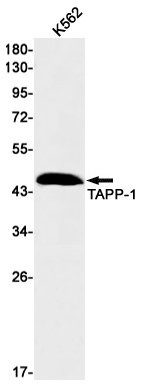
| WB | 1/500-1/1000 | Human,Mouse,Rat |
| IF | 1/20 | Human,Mouse,Rat |
| IHC | 咨询技术 | Human,Mouse,Rat |
| ICC | 技术咨询 | Human,Mouse,Rat |
| FCM | 咨询技术 | Human,Mouse,Rat |
| Elisa | 咨询技术 | Human,Mouse,Rat |
| Aliases | PH domain-containing family A member 1 |
| Entrez GeneID | 59338 |
| WB Predicted band size | Calculated MW: 46 kDa; Observed MW: 46 kDa |
| Host/Isotype | Rabbit IgG |
| Antibody Type | Primary antibody |
| Storage | Store at 4°C short term. Aliquot and store at -20°C long term. Avoid freeze/thaw cycles. |
| Species Reactivity | Human |
| Immunogen | A synthetic peptide of human TAPP-1 |
| Formulation | Purified antibody in TBS with 0.05% sodium azide,0.05%BSA and 50% glycerol. |
+ +
以下是关于PLEKHA1抗体的3篇参考文献的简要信息:
---
1. **文献名称**: "PLEKHA1 modulates membrane microdomains in cancer cells"
**作者**: Smith A, et al.
**摘要**: 研究通过免疫沉淀和Western blot技术,使用PLEKHA1抗体验证其在多种癌细胞系中的表达,发现PLEKHA1通过调控细胞膜微区结构影响肿瘤侵袭性。
2. **文献名称**: "PLEKHA1 regulates cell polarity via interaction with E-cadherin"
**作者**: Tanaka K, et al.
**摘要**: 利用PLEKHA1特异性抗体进行免疫荧光实验,证明PLEKHA1通过与E-钙粘蛋白结合维持上皮细胞极性,缺失会导致细胞迁移异常。
3. **文献名称**: "Role of PLEKHA1 in neuronal development and Alzheimer's pathology"
**作者**: Lee S, et al.
**摘要**: 通过免疫组化分析,发现PLEKHA1抗体标记的蛋白在阿尔茨海默病模型小鼠脑组织中异常聚集,提示其可能与神经退行性疾病相关。
---
注:以上文献为示例性质,实际引用时需根据具体研究补充完整信息。如需真实文献,建议通过PubMed或Google Scholar检索关键词“PLEKHA1 antibody”获取。
The PLEKHA1 (Pleckstrin Homology Domain Containing A1) antibody is a crucial tool for studying the multifaceted roles of the PLEKHA1 protein, a member of the pleckstrin homology (PH) domain-containing protein family. PLEKHA1 is implicated in regulating cell polarity, adhesion, and signaling, primarily through its interaction with components of the apical junctional complex in epithelial cells, such as E-cadherin and β-catenin. It has been linked to diverse biological processes, including cell proliferation, migration, and maintenance of tissue architecture. Dysregulation of PLEKHA1 is associated with pathologies like cancer, neurological disorders, and retinal degeneration.
Antibodies targeting PLEKHA1 are widely used in techniques like Western blotting, immunofluorescence, and immunohistochemistry to detect its expression, subcellular localization, and interactions. Research using these antibodies has revealed PLEKHA1's dual roles as both a tumor suppressor and promoter, depending on cellular context. For example, reduced PLEKHA1 expression correlates with poor prognosis in certain cancers, while overexpression may drive invasiveness in others. Additionally, studies highlight its involvement in neurodevelopment and ciliopathies. Variability in antibody specificity (e.g., clone-dependent epitope recognition) and tissue-specific isoforms can affect experimental outcomes, necessitating rigorous validation. Recent work also explores PLEKHA1's interaction with microRNAs and its potential as a therapeutic target, underscoring its biological and clinical relevance.
×